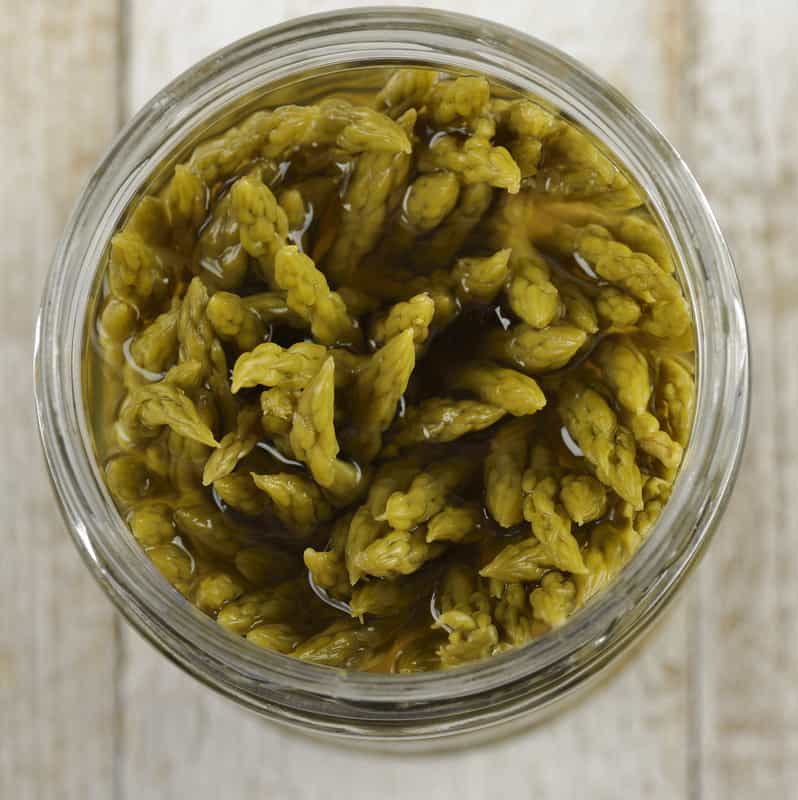
Home grown asparagus can be cut for canning the second spring after planting. The harvest time lasts 4 to 6 weeks and begins when temperatures rise above 55°F. Then asparagus sends up stalks from its thick underground roots.
Asparagus stalks grow 2 to 3 inches a day in cool weather, 7 to 8 inches a day in warm weather. Cut stalks once they get to about 10 inches high. When a stalk is cut, the plant will send up another and continue doing this until its energy reserves are nearly exhausted.
End your asparagus harvest when only thin spears begin to emerge; that is a sign that the roots are losing strength and need to rest for next year. Then you will want to let the ferny foliage grow on to strengthen the root system for next year’s crop.
Years following the first harvest, plants will be strong enough to lengthen the harvest time to 8 or 10 weeks.
Cut spears at ground level or an inch or so below ground level but not so deep that you cut into or injure the root crown. Use a sharp knife for harvesting; you may be able to find an asparagus knife—it will have a V-shaped notch for a cutting edge.
The best asparagus varieties for canning are Jersey Giant, Jersey Knight, and Purple Passion.
Canned Asparagus
Choose fresh-harvested asparagus for canning; the early stalks will be most tasty. 2½ to 4½ pounds fresh asparagus will yield 1 quart.
Instructions
- Wash and remove paper-like scales from the sides of stalks. Cut off tough woody ends.
- Cut whole stalks into lengths ¾ to 1 inch shorter than the jar or cut into 1 to 2-inch pieces. (If you are canning pieces, reserve the tips for serving fresh on spring salads, rather than canning.)
- Wash and heat jars and scald the lids and tongs.
- Blanch (that is precook whole stalks or cut pieces in simmering-just boiling water for 1 to 3 minutes) to just wilting—not longer, then plunge stalks quickly into cold water to stop the cooking process–until stalks are cool enough to handle.
- Gather a bundle of stalks with cut end down and pack into jars, not too tightly. Or fill the jars with cut pieces.
- Add salt— ½ teaspoon for pints, 1 teaspoon for quarts. Add boiling water or boiling cooking liquid leaving ½ to 1 inch head space at top of jar. Wipe sealing edge of jar with a clean, damp, lint-free cloth, apply flat lid and ring and hand-tighten screw bands to seal.
- Processing time will differ at different altitudes; at 1,000 feet or less the processing time for steam pressure canner at 10 pounds pressure is 28 minutes for pint jars, 32 minutes for a quart jar; add 1 pound for elevations between 1,001 and 2,000 feet, and ½ pound for each additional 1,000 feet—and processing times will remain the same.
- Lift jar from canner, place on a rack or clean towel and let jars cool to room temperature; this may take 12 to 24 hours. Remove and store screw bands. Check seals. Wipe and label jars. Store jars in a cool, dark place.
Asparagus articles at Harvest to Table:
How to Harvest and Store Asparagus
Seven Ways to Cook and Serve Asparagus
How to Cook Asparagus with No Recipe
Asparagus Growing Problems Troubleshooting
Asparagus Beetle Organic Pest Control















